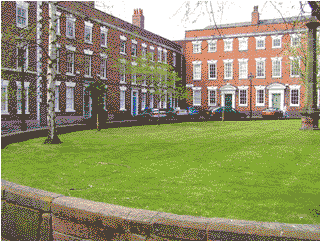Yesterday Jim Downing, Nick Day and I were the guests of Peter Strickland and Brian McMahon at the International Union of Crystallography in their gorgeous offices at Abbey Square, Chester UK
.
The IUCr is a member of ICSU – International Council for Science and as such acts as a governing body. It has taken a very proactive role over the last 5 decades (and probably more, but I can’t remember) on things like data quality, standards, creating a community. So do all Scientific Unions – such as IUPAC (which recently did me the honour of making me a fellow) – but I hope I’m not divisive in giving the IUCr some individual praise.
I remember IUCr running an community exercise – I think in the 1950/1960 period – where labs were invited to collect data sets from a standard crystal (something like sodium ammonium tartrate, but I forget). That meant that the community could estimate the precision and accuracy that might be possible at that time. The philosophy has continued, and of course technology is much improved so that routine crystallographic data has excellent precision and accuracy. The IUCr has also emphasized the publication of data sets – as part of the scientific record, to check for and with the expectation that future scientists might revisit data sets and re-use them. (For example when I did my doctorate the programs couldn’t model anisotropic scattering from atoms and it would be easy to re-analyse the data. The IUCr has always promoted the publication of the raw data and it’s due to their advocacy that Nick Day has been able to create CrystalEye – WWMM from the supplemental crystallographic data that many responsible scientific publishers mount on their websites. The IUCr had given us some initial support for a summer student – Mark Holt – and we were showing where it had got to. CrystalEye is an excellent model for harvesting data from publisher sites – at least those who don’t try to posses public domain data. More on all of this later.
The IUCr is also a publisher – its flagship journal is Acta Crystallographica (sections A-F). CrystalEye takes data mainly from E, C and parts of B. Acta has a hybrid approach to OA – the cost to authors is 900 USD which is a lot less than most. I think we can expect more developments in this area.
-
Recent Posts
-
Recent Comments
- pm286 on ContentMine at IFLA2017: The future of Libraries and Scholarly Communications
- Hiperterminal on ContentMine at IFLA2017: The future of Libraries and Scholarly Communications
- Next steps for Text & Data Mining | Unlocking Research on Text and Data Mining: Overview
- Publishers prioritize “self-plagiarism” detection over allowing new discoveries | Alex Holcombe's blog on Text and Data Mining: Overview
- Kytriya on Let’s get rid of CC-NC and CC-ND NOW! It really matters
-
Archives
- June 2018
- April 2018
- September 2017
- August 2017
- July 2017
- November 2016
- July 2016
- May 2016
- April 2016
- December 2015
- November 2015
- September 2015
- May 2015
- April 2015
- January 2015
- December 2014
- November 2014
- September 2014
- August 2014
- July 2014
- June 2014
- May 2014
- April 2014
- March 2014
- February 2014
- January 2014
- December 2013
- November 2013
- October 2013
- September 2013
- August 2013
- July 2013
- May 2013
- April 2013
- March 2013
- February 2013
- January 2013
- December 2012
- November 2012
- October 2012
- September 2012
- August 2012
- July 2012
- June 2012
- May 2012
- April 2012
- March 2012
- February 2012
- January 2012
- December 2011
- November 2011
- October 2011
- September 2011
- August 2011
- July 2011
- May 2011
- April 2011
- March 2011
- February 2011
- January 2011
- December 2010
- November 2010
- October 2010
- September 2010
- August 2010
- July 2010
- June 2010
- May 2010
- April 2010
- August 2009
- July 2009
- June 2009
- May 2009
- April 2009
- March 2009
- August 2008
- July 2008
- June 2008
- May 2008
- April 2008
- March 2008
- February 2008
- January 2008
- December 2007
- November 2007
- October 2007
- September 2007
- August 2007
- July 2007
- June 2007
- May 2007
- April 2007
- December 2006
- November 2006
- October 2006
- September 2006
-
Categories
- "virtual communities"
- ahm2007
- berlin5
- blueobelisk
- chemistry
- crystaleye
- cyberscience
- data
- etd2007
- fun
- general
- idcc3
- jisc-theorem
- mkm2007
- nmr
- open issues
- open notebook science
- oscar
- programming for scientists
- publishing
- puzzles
- repositories
- scifoo
- semanticWeb
- theses
- Uncategorized
- www2007
- XML
- xtech2007
-
Meta